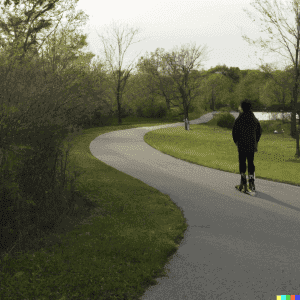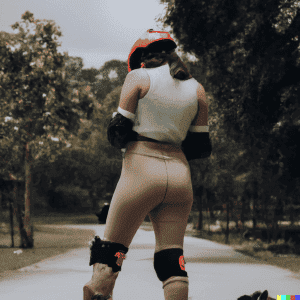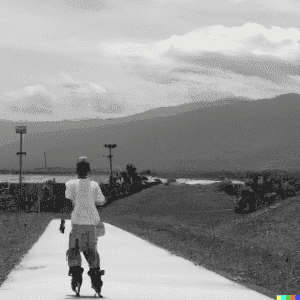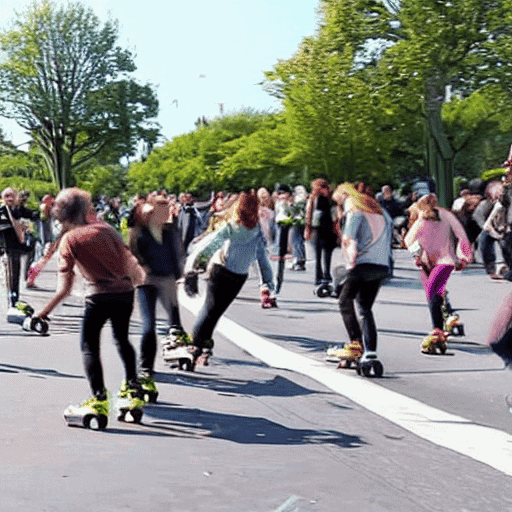Table Of Contents
With the cost of fuel at the moment, it’s a great time to explore other forms of transport. Whilst inline skating may be considered a recreational activity, inline skates can also be used as a form of transport.
In this article, we will look at skating as an alternative form of transport, the basic equipment required and some other surprising benefits of inline skating.
Roller Derby Aerio Women's Inline Skates
(as of 07/25/2024 14:17 GMT +01:00 - More infoProduct prices and availability are accurate as of the date/time indicated and are subject to change. Any price and availability information displayed on [relevant Amazon Site(s), as applicable] at the time of purchase will apply to the purchase of this product.)Inline skating is a great eco-method of transportation.

Inline skating, also known as Rollerblading, is a great alternative to traditional methods of transportation such as walking, biking, or driving.
It’s relatively cheap and easy to get started. All you need is a pair of skates, a helmet, and some basic safety gear.
And unlike biking or driving, inline skating doesn’t produce any emissions, so it’s environmentally friendly. Inline skating is also a great workout.
You’ll need some basic equipment to get started.

If you’re new to inline skating, you’ll need to purchase some basic equipment before you get started.
The most important piece of equipment is a pair of skates.
Depending on where and what type of skating you’re going to be doing, you need to choose the right skates.
If you are just starting out and your bit unsteady on your feet then I would suggest quad skates as your first purchase.
If you are more confident and intended to be doing a lot of outside skating, then I would choose inline skates/rollerblades.
You’ll also need a helmet, knee pads, elbow pads, and wrist guards for safety.
Once you have all the necessary equipment, you’re ready to start skating!
OutdoorMaster Skateboard Cycling Helmet - Two Removable Liners Ventilation Multi-Sport Scooter Roller Skate Inline Skating Rollerblading for Kids, Youth & Adults
(as of 07/25/2024 14:17 GMT +01:00 - More infoProduct prices and availability are accurate as of the date/time indicated and are subject to change. Any price and availability information displayed on [relevant Amazon Site(s), as applicable] at the time of purchase will apply to the purchase of this product.)Inline skating is relatively easy to learn.
Contrary to popular belief, inline skating is not difficult to learn.
With a little practice, most people can learn the basics within a few hours.
The key is to start slow and practice in a safe area.
Once you get the hang of it, you can gradually increase your speed and skating distance.
Inline skating is a great way to explore new places.

If you’re planning a trip, look for trails or parks that are specifically designed for inline skating.
This way, you can be sure that the surface is smooth and safe for skating.
You can also find maps of local skate parks and trails online.
If you’re thinking about giving inline skating a try, keep these things in mind.
Inline skating is a great alternative to traditional methods of transportation, it’s eco-friendly and can help you get some exercise, and it’s relatively easy to learn.
Triple Eight Saver Series Pad Set with Kneesavers, Elbowsavers and Wristsavers
(as of 07/25/2024 14:17 GMT +01:00 - More infoProduct prices and availability are accurate as of the date/time indicated and are subject to change. Any price and availability information displayed on [relevant Amazon Site(s), as applicable] at the time of purchase will apply to the purchase of this product.)Heel Brake Inline Skates
A heel brake is a small rubber pad that is attached to the back of an inline skate.
When the skater leans back and applies pressure to the heel, the brake pad makes contact with the ground and slows or stops the skate.
Heel brakes are a popular choice for beginners because they are easy to use and provide a reliable way to stop.
How to Use Heel Brake Inline Skates?
Step 1: Get into Skating Position
Before you start using the heel brake on inline skates, it’s important to make sure that you’re in the correct skating position.
Stand with your feet shoulder-width apart and your knees slightly bent. Keep your arms out to your sides for balance.
Step 2: Press the Heel Brake Down to Slow Down or Stop
Place one foot in front of the other and slightly lift your toe up, this will engage the brake on the heel.
The more pressure you apply the fast you will stop. It’s important to remember to keep your balance and not lean too far forward or backwards when using the brake.
Practice using the heel brake on inline skates in a safe and controlled environment until you feel comfortable and confident using it in different situations.
Remember to always wear protective gear, including a helmet, wrist guards, and knee pads, when skating.
Is Inline Skating as Effective for Health and Weight Loss as Roller Skating?
When comparing inline skating and roller skating health benefits, both activities contribute to overall fitness. Inline skating targets muscles in the lower body, enhancing cardiovascular health and promoting weight loss.
Roller skating offers similar advantages by engaging core muscles and improving balance. Ultimately, both sports offer effective options for health and weight management.
What Safety Tips Should I Keep in Mind When Trying Inline Skating as an Eco-Friendly Mode of Transportation?
When trying inline skating as an eco-friendly mode of transportation, it is crucial to keep certain safety tips in mind.
Wear appropriate protective gear, such as a helmet, knee pads, and wrist guards.
Choose a smooth and traffic-free area to skate. Additionally, maintain good control, balance and posture while skating, and learn how to stop properly.
Consider taking lessons or seeking guidance to improve your skills and ensure a safe inline skating experience. Remember, following tips for safe inline skating will help you enjoy this sustainable mode of transportation with confidence.
Conclusion
Inline skating is an eco-activity that can help the environment while providing a fun and exciting way to stay active.
With the right gear and the right attitude, inline skating can be a great way to get outdoors and enjoy nature. It’s also an activity that’s accessible to all ages, skill levels, and budgets.
JeeFree Adjustable Color Gradient Skateboard Helmet for 3-5-8-14+Ages【Toddler Kids Youth Adult】 Girls Boys Woman.Bike Helmet for Multi-Sports Cycling Bicycle Scooter Inline Roller Skate Rollerblading
(as of 07/25/2024 14:17 GMT +01:00 - More infoProduct prices and availability are accurate as of the date/time indicated and are subject to change. Any price and availability information displayed on [relevant Amazon Site(s), as applicable] at the time of purchase will apply to the purchase of this product.)FAQ
How fast can you go on inline skates?
The average speed for inline skating is about 15 miles per hour, but some people can skate much faster.
How do you stop on inline skates?
There are several ways to stop when using inline skates.
One way to stop on inline skates is to use the heel brake. To do this, you need to lean back and push down on the heel brake of your skates.





